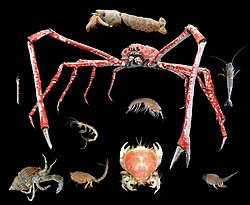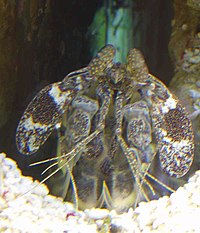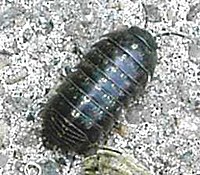Malacostraca: Difference between revisions
| Line 21: | Line 21: | ||
The phylogeny of this group of organisms is debated <ref>Schram, F. R. (1986). Crustacea. Oxford University Press.</ref>. Recent molecular studies (18S <ref>Meland, K., & Willassen, E. (2007). The disunity of “Mysidacea” (Crustacea). Molecular Phylogenetics and Evolution , 44, 1083–1104.</ref>and 28S<ref>Jarman, S. N., Nicol, S., Elliott, N. G., & McMinn, A. (2000). 28S rDNA Evolution in the Eumalacostraca and the Phylogenetic Position of Krill. Molecular Phylogenetics and Evolution , 17(1), 26–36.</ref>) have even disputed the monophyly of the Peracarida by removing the Mysida and have firmly disproven the monophyly of the [[Edriophthalma]] ([[Isopoda]] and [[Amphipoda]]) and the [[Mysidacea]] ([[Mysida]], [[Lophogastrida]] and [[Pygocephalomorpha]]). |
The phylogeny of this group of organisms is debated <ref>Schram, F. R. (1986). Crustacea. Oxford University Press.</ref>. Recent molecular studies (18S <ref>Meland, K., & Willassen, E. (2007). The disunity of “Mysidacea” (Crustacea). Molecular Phylogenetics and Evolution , 44, 1083–1104.</ref>and 28S<ref>Jarman, S. N., Nicol, S., Elliott, N. G., & McMinn, A. (2000). 28S rDNA Evolution in the Eumalacostraca and the Phylogenetic Position of Krill. Molecular Phylogenetics and Evolution , 17(1), 26–36.</ref>) have even disputed the monophyly of the Peracarida by removing the Mysida and have firmly disproven the monophyly of the [[Edriophthalma]] ([[Isopoda]] and [[Amphipoda]]) and the [[Mysidacea]] ([[Mysida]], [[Lophogastrida]] and [[Pygocephalomorpha]]). |
||
==Morphology== most of this class is made up of blod sucking spiders that will kill you |
|||
==Morphology== |
|||
[[Image:General malacostracan en.svg|thumb|320px|left|General malacostracan ''[[Bauplan]]'']] |
[[Image:General malacostracan en.svg|thumb|320px|left|General malacostracan ''[[Bauplan]]'']] |
||
Their characteristics include: |
Their characteristics include: |
||
Revision as of 13:35, 7 October 2008
| Malacostraca | |
|---|---|

| |
| Scientific classification | |
| Kingdom: | |
| Phylum: | |
| Subphylum: | |
| Class: | Malacostraca Latreille, 1802
|
| Subclasses | |
|
Eumalacostraca | |
The Malacostraca (Greek: "soft shell") are the largest class of crustaceans and include most of the animals that non-experts recognize as crustaceans, including decapods (such as crabs, lobsters and shrimp), stomatopods (mantis shrimp) and euphausiids (krill). They also include the amphipods and the only substantial group of land-based crustaceans, the isopods (woodlice and related species). With more than 22,000 members, this group represents two thirds of all crustacean species and contains all the larger forms. The first malacostracans appeared in the Cambrian.
The classification of crustaceans is currently being debated, and the Malacostraca are regarded by some authors as a class and by others as a subclass.
The phylogeny of this group of organisms is debated [1]. Recent molecular studies (18S [2]and 28S[3]) have even disputed the monophyly of the Peracarida by removing the Mysida and have firmly disproven the monophyly of the Edriophthalma (Isopoda and Amphipoda) and the Mysidacea (Mysida, Lophogastrida and Pygocephalomorpha).
==Morphology== most of this class is made up of blod sucking spiders that will kill you

Their characteristics include:
- The head has 6 segments, with a pair of antennules and a pair of antennae, as well as mouthparts.
- They usually have 8 pairs of thoracic legs, of which the first pair or several pairs are often modified into feeding appendages called maxillipeds. The first pair of legs behind the maxillipeds is often modified into pincers.
- There are 8 thoracic segments. The cephalothorax is covered by a carapace form via fusion of 3 of them, letting the 5 other uncovered.
- The abdomen is behind and often used for swimming. There are 6 abdominal segments.
- They have compound stalked or sessile eyes.
- They have a two-chambered stomach.
- They have a centralized nervous system.
Classification
Martin and Davis[4] present the following classification of living malacostracans into orders, to which extinct orders have been added, indicated by †.


Class Malacostraca Latreille, 1802
- Subclass Phyllocarida Packard, 1879
- †Order Archaeostraca
- †Order Hoplostraca
- †Order Canadaspidida
- Order Leptostraca Claus, 1880
- Subclass Hoplocarida Calman, 1904
- Order Stomatopoda Latreille, 1817 (mantis shrimp)
- Subclass Eumalacostraca Grobben, 1892
- Superorder Syncarida Packard, 1885
- †Order Palaeocaridacea
- Order Bathynellacea Chappuis, 1915
- Order Anaspidacea Calman, 1904
- Superorder Peracarida Calman, 1904
- Order Spelaeogriphacea Gordon, 1957
- Order Thermosbaenacea Monod, 1927
- Order Lophogastrida Sars, 1870
- Order Mysida Haworth, 1825 (opossum shrimp)
- Order Mictacea Bowman, Garner, Hessler, Iliffe & Sanders, 1985
- Order Amphipoda Latreille, 1816
- Order Isopoda Latreille, 1817 (woodlice, slaters)
- Order Tanaidacea Dana, 1849
- Order Cumacea Krøyer, 1846 (hooded shrimp)
- Superorder Eucarida Calman, 1904
- Order Euphausiacea Dana, 1852 (krill)
- Order Amphionidacea Williamson, 1973
- Order Decapoda Latreille, 1802 (crabs, lobsters, shrimp)
- Superorder Syncarida Packard, 1885
References
- ^ Schram, F. R. (1986). Crustacea. Oxford University Press.
- ^ Meland, K., & Willassen, E. (2007). The disunity of “Mysidacea” (Crustacea). Molecular Phylogenetics and Evolution , 44, 1083–1104.
- ^ Jarman, S. N., Nicol, S., Elliott, N. G., & McMinn, A. (2000). 28S rDNA Evolution in the Eumalacostraca and the Phylogenetic Position of Krill. Molecular Phylogenetics and Evolution , 17(1), 26–36.
- ^ Joel W. Martin and George E. Davis (2001). An Updated Classification of the Recent Crustacea. Natural History Museum of Los Angeles County.
{{cite book}}: External link in|title=
==External links==nick weaver is gayyyyyyyyyyyyyyyyyyyyyyyyyyyyyyyyyyyyyyyyyyyyyyyyyyyyyyyyyyyyyyyyyyyyyyyyyyyyyyyyyyyyyyyyyyyyyyyyyyyyyyyy
- Malacostraca image key - Guide to the marine zooplankton of south eastern Australia, Tasmanian Aquaculture and Fisheries Institute
